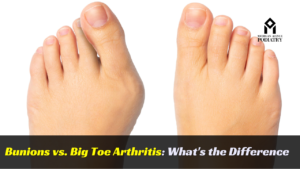In the intricate world of foot problems, two prevalent conditions often perplex individuals: hammertoe and bunion. While both affect the foot and cause discomfort, they are distinct entities with unique characteristics. Understanding their disparities is crucial for accurate diagnosis and effective treatment. Let’s delve into the dissimilarities between hammertoe and bunion, shedding light on these common foot ailments.
Hammertoe: The Curved Conundrum
Hammertoe, aptly named for its resemblance to a bent hammer, manifests when the middle joint of the toe becomes permanently bent, resembling a claw. This deformity can occur in any toe but typically affects the second, third, or fourth toes.
Causes of Hammertoe:
Several factors contribute to the development of hammertoe, including:
- Footwear: Ill-fitting shoes, especially those with narrow toe boxes or high heels, can force the toes into unnatural positions, leading to hammertoe.
- Genetics: Hereditary predisposition plays a role, as certain foot structures inherited from parents can increase the likelihood of hammertoe.
- Muscle Imbalance: Weak muscles and tendons in the toe can result in imbalance, causing the toe to bend abnormally over time.
Symptoms of Hammertoe:
Recognizing the signs of hammertoe is crucial for early intervention. Symptoms may include:
- Toe Deformity: The affected toe appears bent at the middle joint, resembling a hammer.
- Pain and Discomfort: Individuals may experience pain or discomfort, particularly when wearing shoes or walking.
- Corns and Calluses: Pressure and friction from shoes can lead to the formation of corns or calluses on the top of the affected toe.
Bunion: The Bump Dilemma
On the other hand, a bunion is characterized by a bony bump that forms at the base of the big toe. This protrusion develops when the big toe deviates inward toward the second toe, causing the joint at the base of the big toe to protrude outward.
Causes of Bunion:
Understanding the underlying causes of bunions can aid in prevention and management:
- Foot Structure: Individuals with certain foot shapes, such as flat feet or low arches, may be more prone to developing bunions.
- Footwear: Tight, narrow shoes can exacerbate bunions by crowding the toes and putting pressure on the joint.
- Heredity: Genetic factors can predispose individuals to bunions, as certain foot shapes and structures may run in families.
Symptoms of Bunion:
Identifying the symptoms of a bunion can facilitate prompt treatment and alleviate discomfort:
- Bony Bump: A noticeable bump at the base of the big toe is a hallmark sign of a bunion.
- Toe Misalignment: The big toe may drift toward the second toe, causing misalignment and potentially overlapping of toes.
- Pain and Inflammation: Bunions can cause pain, swelling, and redness around the affected joint, particularly during movement or when wearing shoes.
Distinguishing Features: Hammertoe vs Bunion
While hammertoe and bunion share some similarities, several key distinctions set them apart:
- Affected Toe: Hammertoe primarily affects the middle joints of the smaller toes, while a bunion occurs at the base of the big toe.
- Deformity Shape: Hammertoe results in a claw-like curvature of the affected toe, whereas a bunion presents as a bony bump at the joint.
- Underlying Causes: Hammertoe often stems from muscle imbalance or improper footwear, whereas bunions are influenced by foot structure and hereditary factors.
- Location of Pain: Hammertoe may cause discomfort on the top of the affected toe, while bunions typically result in pain and inflammation around the base of the big toe.
Seeking Professional Guidance: The Role of a Podiatrist
When faced with foot problems such as hammertoe or bunion, seeking professional evaluation and treatment from a podiatrist is paramount. A podiatrist can provide a comprehensive assessment, accurately diagnose the condition, and recommend personalized treatment options tailored to individual needs.
Treatment Options:
Depending on the severity of the condition, treatment for hammertoe and bunion may include:
- Conservative Measures: This may involve wearing orthotic devices, padding, or splints to alleviate symptoms and prevent further progression.
- Footwear Modifications: Switching to shoes with wider toe boxes and lower heels can relieve pressure and improve comfort.
- Physical Therapy: Stretching and strengthening exercises can help correct muscle imbalances and improve toe alignment.
- Surgical Intervention: In cases where conservative measures are ineffective, surgical correction may be necessary to realign the toes and alleviate pain.
Conclusion:
In summary, while hammertoe and bunion may both affect the feet and cause discomfort, they are distinct conditions with unique characteristics and underlying causes. Recognizing the differences between these ailments is crucial for accurate diagnosis and effective management. By understanding the symptoms, causes, and treatment options for hammertoe and bunion, individuals can take proactive steps to maintain foot health and alleviate discomfort.




